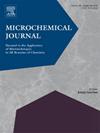通过装饰在氧化石墨烯和金纳米粒子上的合成受体识别 C 反应蛋白的等离子传感平台
IF 4.9
2区 化学
Q1 CHEMISTRY, ANALYTICAL
引用次数: 0
摘要
C 反应蛋白(CRP)水平为预测心血管疾病、慢性炎症和神经退行性疾病等多种疾病提供了有关个人健康状况的重要信息。因此,测定 CRP 水平对于正确的健康干预和治疗跟踪非常重要。为了选择性地检测 CRP,我们开发了一种(GO/Au-MIP)SPR 传感器,其中包含用氧化石墨烯和金纳米粒子修饰的 CRP 压印聚合物。为了证明氧化石墨烯(GO)和金纳米粒子(AuNPs)的存在提高了传感器的灵敏度,我们采用相同的方法制备了 CRP 压印(MIP)SPR 传感器,但没有加入 GO 和 AuNPs。此外,还制备了非压印 GO/Au-NIP SPR 传感器,以评估压印效率。在检测 PBS 缓冲液中的 CRP 时,GO/Au-MIP SPR 传感器在 0.1-2 ppm(R = 0.9721)和 5-100 ppm(R = 0.9740)的浓度范围内呈线性关系。所制备传感器的检测限为 0.0082 ppm。研究还通过计算压印因子值(I.F=13.84)评估了压印过程的效率。在选择性研究中,GO/Au-MIP SPR 传感器对 CRP 蛋白的选择性是牛血清白蛋白的 9.23 倍,是血红蛋白的 29.53 倍。在对 GO/Au-MIP SPR 传感器的可重复性进行检测时,结果表明 GO/Au-MIP SPR 传感器能够检测 CRP,连续重复使用五次,性能没有任何下降(RSD<1.5)。最后,GO/Au-MIP SPR 传感器还对血清和尿液中的 CRP 进行了检测研究,选取血清和尿液作为真实样品,以评估基质效应。CRP 加标血清样品采用另一种标准方法进行分析,以验证 CRP 分析仪的分析结果。本文章由计算机程序翻译,如有差异,请以英文原文为准。
Plasmonic sensing platform for C-reactive protein recognition via synthetic receptors decorated on graphene oxide and gold nanoparticles
C-reactive protein (CRP) level provides important information about the health status of the individual in predicting many diseases such as cardiovascular, chronic inflammatory, and neurodegenerative diseases. Therefore, determining CRP levels is important for correct health intervention and treatment follow-up. For the selective detection of CRP, we developed a (GO/Au-MIP) SPR sensor containing CRP-imprinted polymer modified with graphene oxide and gold nanoparticles. To prove the enhanced sensitivity of the sensor resulting from the presence of graphene oxide (GO) and gold nanoparticles (AuNPs), a CRP-imprinted (MIP) SPR sensor was prepared using the same method, excluding the incorporation of GO and AuNPs. In addition, a non-imprinted GO/Au-NIP SPR sensor was also prepared to evaluate the imprinting efficiency. In detecting CRP in PBS buffer, the GO/Au-MIP SPR sensor exhibited linearity in the concentration ranges of 0.1–2 ppm (R = 0.9721) and 5–100 ppm (R = 0.9740). The detection limit of the prepared sensor was calculated as 0.0082 ppm. In the study, the imprinting process efficiency was also evaluated by calculating the imprinting factor value (I.F=13.84). In the selectivity studies, the GO/Au-MIP SPR sensor was determined to be 9.23 times more selective against CRP protein than bovine serum albumin and 29.53 times more selective than hemoglobin. When the repeatability of the GO/Au-MIP SPR sensor was examined, it was determined that the GO/Au-MIP SPR sensor was able to detect CRP without any deterioration in performance in five consecutive reuses (RSD<1.5). Finally, CRP detection studies from the serum and urine solutions, which were selected as real samples, were carried out by the GO/Au-MIP SPR sensor to evaluate the matrix effect. CRP spiked serum sample was analyzed by the other standard method to validate the analytical results using CRP analyser.
求助全文
通过发布文献求助,成功后即可免费获取论文全文。
去求助
来源期刊

Microchemical Journal
化学-分析化学
CiteScore
8.70
自引率
8.30%
发文量
1131
审稿时长
1.9 months
期刊介绍:
The Microchemical Journal is a peer reviewed journal devoted to all aspects and phases of analytical chemistry and chemical analysis. The Microchemical Journal publishes articles which are at the forefront of modern analytical chemistry and cover innovations in the techniques to the finest possible limits. This includes fundamental aspects, instrumentation, new developments, innovative and novel methods and applications including environmental and clinical field.
Traditional classical analytical methods such as spectrophotometry and titrimetry as well as established instrumentation methods such as flame and graphite furnace atomic absorption spectrometry, gas chromatography, and modified glassy or carbon electrode electrochemical methods will be considered, provided they show significant improvements and novelty compared to the established methods.
 求助内容:
求助内容: 应助结果提醒方式:
应助结果提醒方式:


